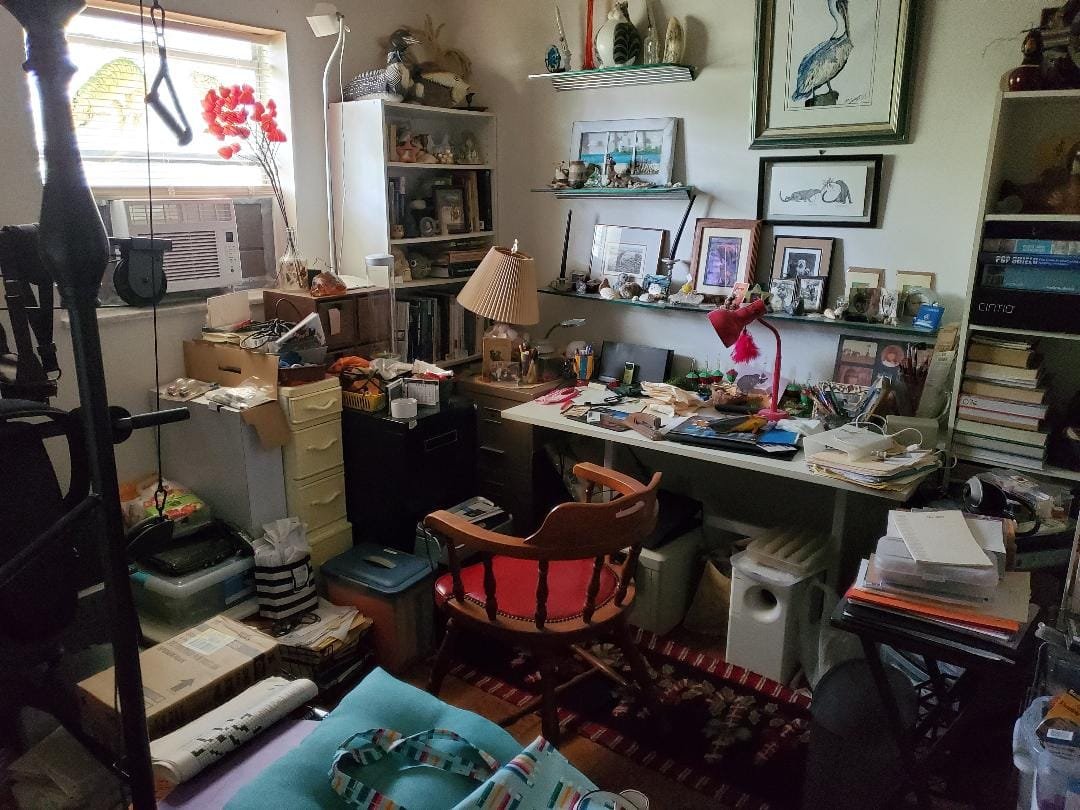
Clutter is metastatic, it spreads itself everywhere and into places you would never expect to find it. You might not notice it, but it’s there, sometimes even out of sight, but waiting, lurking, and infectious.
Sometimes it’s gregarious. I know because it follows me, as if to stay sociable. Not only in my house, but my car, the garage, and even in my pockets.
I swear I wasn’t this way – cluttered – before I got married. It was easy not to be cluttered then, when we didn’t have much of anything. I guess when you don’t have money, you won’t have lots of “things”, and you won’t have clutter.
We’ve been married a long time, a very long time. The clutter has been prolific; it has gender and it’s easy to assign ownership to it.
And so, we now have his and hers rooms for clutter with neither of us willing to clean our own clutter. But we are willing to clean the other’s, as in:
My husband, Howard: “You know, you have an awful lot of things you don’t use. If you don’t use them, why don’t we just throw them out?”
Me: “I have a better idea. Why don’t we start in your room? ”
Howard: Silence.
I studied biology in college. Based on its characteristics, I think clutter could be a life form. It grows, and its growth habits are versatile. It can form wide lateral spreads, huge piles, or even steep stacks. It’s invasive, devious, and it will even chase you from one room into another, from one place to another.
Most people claim that inanimate things lack sentience, but I’m not so sure about clutter because when it comes to mountains of clutter – I’m its prey. A trip, a fall over just a smidgen of clutter can send me, an agile, nimble-footed person (ha!ha!) to the hospital.
We have a huge dining room table which also serves as a work table. The clutter is either “his” or “hers”.
Howard: “Where are the scissors?”
Me: ”I dunno.”
Howard – looking all over table, lifting up papers, moving pens, napkins, “There they are, cuddling with your sunglasses, your papers. “
Clutter! So devious and so diversified that It can be categorized – physical, digital, psychological…
It is digital when my hard drive is over flowing with files, constipated by heaps of useless, obsolete information, and the desktop checkered with unused files and icons.
Me, complaining to my husband, Howard: “My computer is hanging and slow.”
Howard: “No wonder, look at your desktop, so many files. Why don’t you clear them out?”
Me: “But I need them, if I put them someplace else, I’ll forget I have them.”
And so it goes. The wants and needs for items of clutter are strong although probably unnecessary.
Physical clutter is very often male. It can mottle a room with tools and other unused gizmos, all embedded in a sea of testosterone and lassitude.
Me: “Howard, I almost killed myself stepping over a skill saw while trying to get to the computer. Can’t you move it?”
Howard: “Why?
Me: “The sight of it makes me itch.”
Howard: “But I might need it to fix something…”
It’s a psychological issue when my cluttered brain is filled with procrastination, defunct ideas, and stupefied thought. These induce mental inertia. A cluttered cerebral cortex is almost as bad as a fecal impaction, just not as odiferous or befouled.
My own clutter is adaptable. It often forms:
Doom piles. (Not to be confused with those fractious, anal varicosities also called piles). My doom piles can move. I swear they can crawl. They also reproduce, thankfully asexually…fragmentation, fission, maybe even parthenogenesis… But, thankfully, no sexual reproduction. What a messy affair that would be!

Doom pile heights appear to be limited. A high doom pile is unstable. There is nothing worse than a six foot high doom pile when it collapses.
Although unlimited growth is not an option, doom piles tend to stick together in high humidity, and South Florida doom piles use high humidity to their advantage when they need to call on each other for reinforcements. And If they do end up on the floor, doom piles will go out of their way to trip you.
Maybe doom piles and other sorts of clutter deserve a more specific classification system, like a taxonomy of their own, with their contents and appearance being the basis for hierarchal categories and maybe even a taxonomic key. We would have a more detailed framework for comparison of the different kinds of clutter and be able to better understand their origins and causes.
But that would clutter our time constraints for doing other things, like taking disposed of clutter out to the garbage.
I want so much to be organized. I want to make simplicity, elegance, and organization the focal point of my life. I want to be efficient and I don’t want well meaning family members calling HRS or staging an intervention. No need to call a professional declutterer or worse yet, send in a therapist.
But if I really want to find simplicity and organization, I will have to eliminate the clutter and doom piles. However, my insecurities and creativity are tied up in that clutter. That clutter is a compilation of my thoughts, memories, obligations, creativity, and intellectual meanderings. My brains are on those pieces of paper scattered throughout the house. To clear it all out would be like losing my mind.